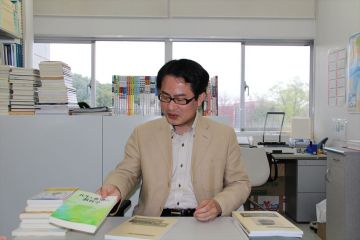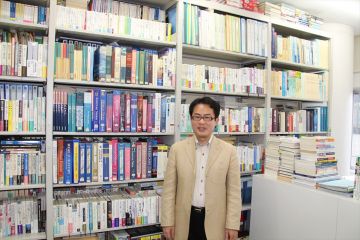TSUKUBA FUTURE
#041 Pursuing Historical Awareness from the Perspective of a Symbiotic Society
Associate Professor OKAMOTO Tomochika, Faculty of Human Sciences

Are you familiar with the phrase "symbiotic society"? It refers to a society that provides support to people who have typically found it difficult to participate in society, such as disabled individuals and minorities; that is, a society that adopts policies to ensure that all people can live together with one another symbiotically. People from different countries who have different cultural and religious backgrounds are increasingly present all around us. Education plays an important role in achieving a symbiotic society. I am conducting research in the field of symbiotic pedagogy, a subfield of pedagogy.
In its current Courses of Study, last revised in 2008, the Ministry of Education, Culture, Sports, Science and Technology identified "the ability to live with others" as one of the three key components of having "zest for life." The ministry suggests that it is important to cultivate the "ability to be self-disciplined and to live with others" as one of the "skills for surviving in society." The "ability to live with others" is, in other words, "symbiosis." Prof. Okamoto has formed a Symbiotic Education Research Group with other pedagogy instructors in the Faculty of Human Sciences, and is investigating the possibility of providing education that achieves "symbiosis." To obtain basic materials for this research project, he conducted a social attitude survey on symbiosis among adults and high school students from 2013 to 2014. The survey asked what it means for human beings to live in symbiosis with one another and how symbiosis is understood in society. The results showed that high school students are even more familiar with the phrase "symbiotic society" than adults. This suggests that the concept is being taught in schools. The results also revealed generational differences in attitudes, as well as differences based on educational and social experience. Generally speaking, individuals who indicate tolerance toward exchanges with people from other countries tend to have a deeper understanding of the issues involved in living symbiotically with others ("Survey on the Concept of Symbiotic Society" and "Survey on the Relationship of High School Students to Their Community").

Prof. Okamoto has published many research reports and books.
Some would say that it is appropriate for the Japanese education system to be a system designed for Japanese people. Others would say that it is only natural to divide disabled students from non-disabled students when teaching. However, as globalization and universalization advance, the achievement of a symbiotic society is becoming increasingly necessary, even unavoidable. Dichotomous social frameworks that make distinctions between Japanese and non-Japanese, able-bodied and disabled, are gradually being reshaped into different forms, and eventually will be eliminated altogether. During this transitional period, however, it will be impossible to avoid friction due to differences in people's attitudes and the inability for institutions and frameworks to adapt quickly. In fact, those frictions can already be seen throughout society. Attitudinal and cognitive frameworks about what is considered "good" are instilled in people through education, and since these differ across generations, such frictions are unavoidable. However, as was shown by the attitude survey conducted among high school students, Prof. Okamoto argues that contemporary Japanese education is playing an active role in achieving a symbiotic society.
In his days as a student, one of Prof. Okamoto's goals was to become a social studies teacher. However, around the time he finished high school, the Courses of Study were revised into their current form. When he went to pursue his educational internship while in college, he had to teach from a new history textbook that was different from the ones he had learned from. The content of both the textbook and teaching materials had changed in various ways. One would expect the historical facts to remain constant, even if the Courses of Study are changed, and the fact that the content actually changed when the guidelines were revised was something of a mystery. Given this, Prof. Okamoto decided to study the sociology of education. He began to conduct research on the cyclical relationship between the fact that while society governs education, education also creates social reality. Japanese high school education includes two courses in history: Japanese history and world history. However, this is not generally the case if you look at education around the globe. That is because, in most developed nations, it is widely accepted that the history taught in each nation is not the only version of history. Prof. Okamoto has been focusing on history education in Japan and the US, and the subject of nationalism. An examination of US junior high and high school history textbooks in the 1950s reveals that the content was patriotic and Caucasian-focused. Explanations started with the discovery of the New World during the Age of Exploration. Moving over time into the 1960s and 1970s, the content started to include information on the rising status of minorities and women, and issues relating to new immigrants. The nature of the content being taught changed significantly. Under the Reagan administration in the 1980s, however, the content rebounded back to the earlier content. The voices of those claiming that the distinctly American nature of the content was lost in the emphasis on diversity grew louder, and social forces emerged whose aim was to return to the original material. What happened then is similar to what is happening now in Japan. Even so, we cannot turn back the clock on the social changes Japan is experiencing, such as growing poverty and the increasingly active role of women in society. Those changes, and more, are only going to continue to occur over time.

Bookshelves lined with domestic and international history education materials and books on historical awareness.
Prof. Okamoto argues that if we look at the changes taking place in the way history is being taught from the perspective of symbiosis, we will begin to see the process by which human beings are moving toward greater social symbiosis. The above-mentioned course of events with regard to history textbooks in the US is evidence of this. Within the context of increased globalization, the history of racial interactions has begun to be incorporated into our history textbooks. Educational content is always changing to reflect the needs and issues of the times. Those concepts themselves are revised in accordance with social changes. The current issue is not about being a "society that must achieve symbiosis," but about being a "society where there is no other choice but to live symbiotically." Criticizing this approach based on some sense of nostalgia about "the good old days" might be easy to understand, but it is also irresponsible. What is needed now is not the assertion of a certain generation's values, but wisdom that is achieved when generations with different values are able to learn from one another's perspectives and people are able to understand society in whole new ways. Doubts about standardized knowledge can be seen in the changes that are made in history textbooks. It is important to remember that what one learned oneself may be accurate, but may also not reflect the whole story. Prof. Okamoto has been analyzing criticisms against so-called "pressure-free education" from this perspective. He has concluded that a large part of the misunderstanding comes from the idea that "pressure-free" means "easy." It does not mean that the previous generation received a better education than what is being offered today. There are many problems in society that have no right answers. In this day and age, we need to provide an education that makes students think about how they will put what they've learned to use, an education that nurtures flexibility in creative thought.
Article by Science Communicator at the Office of Public Relations
PREVIOUS
#040 Chasing Dreams


